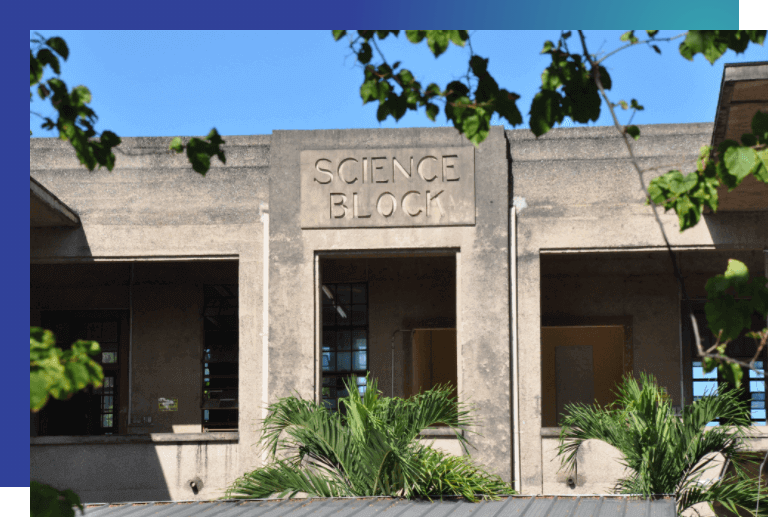HISTORY & ETHOS
About Us

Early history of the Queen’s Royal College Old Boys’ Association
When the College building was opened at Queen’s Park West in 1904, Mr. W. Burslem lamented the little interest shown by Old Boys in the College. Even at that time there were exceptions, such as Dr. S. M. Laurence, or Dr. J. Numa Rat who attended the Queen’s Collegiate School. After 1904, however, a growing number of Old Boys continued their association with the College. Dr. J. A. R Stollmeyer instituted the Stollmeyer medals, the Old Boys prompted by R. S. Aucher Warner collected funds for the Knollys Cup, which introduced regular athletics to the College. After the Great War Old Boys were responsible for the Memorial Tablet in the Hall and for the War Memorial, and on Mr. Burslem’s retirement Old Boys collected the money to establish the Burselm prizes.
At Speech Day, 1931, His Excellency the Governor, Sir A. C. Hollis, suggested the formation of an Old Boys Club, with an annual match and dinner, and perhaps a magazine. Nothing was done about the suggestion, but during the year the Queen’s Royal College Literary Society was formed, and Old Boys were eligible for membership. Although only a few Old Boys were brought to the College in this way, this at the time was regarded as a step towards the formation of an Old Boys Association, and from that time dates the use of this title.
Early in 1934 a small group of Old Boys including Mr. G. C. Grant, Dr. E. H. Farrell, Mr. L.C. Hannays, Mr. H. O. B. Wooding, Dr. F. L. Patrick, Mr. Hamel Wells, did the preliminary work of forming an Association.
On March 23rd a committee drew up a draft of the rules, and at a general meeting on April 28th the rules of the Association were adopted. The first officers of the Association were: Hon. Dr. A. H. McShine, president; C. A. Child, K.C., vice president; Rev. C. S. Doorly, Dr. E. H. Farrell, Hamel Wells, K.C., G. C. Grant, L. C. Hannays, members of committee; A C. Farrell, internal secretary and treasurer, C. H. Archibald, external secretary and treasurer. Mr. Archibald resigned from this office in June, and was replaced by Mr. R. V. M. Clarke, who has continued to hold that office up to the present.
By the middle of 1934 the membership of the Association was 132, and an Inaugural Dinner took place on July 7th at the Hotel Sand. Eighty-seven diners were present. The guests of honour included Hon. Capt. J. O. Cutteridge, Director of Education, Mr. H. H. Hancock, and the Principal and Masters of the College. Up to 1939 the annual dinner continued to be held at the Hotel Sand. In 1940 it was held at the Queen’s Park Hotel, and in 1941 in the College Hall.
Owing to War restrictions the dinner did not take place in 1942 and 1943 but in 1944 it was again held in the College Hall.
VISION STATEMENT
“A vibrant and successful Alumni Association which preserves and enhances the Queen’s Royal College heritage of excellence and promotes the welfare of the College and its community”.
MISSION STATEMENT
“To harness and apply the human, financial and other resources of alumni, benefactors, and well-wishers and build networks and relationships with the College’s stakeholders and among the wider community for the development of outstanding citizens”.

Since the formation of the Association the College has had no confounds for complaint of the lack of interest by the Old Boys, and three of them are now included in the revival College Council. In 1936 arising out of proposals made by Mr. F. C. Marriott at the annual dinner in 1935 that the College should have wings, a special committee was appointed to make representations to Government on matters relating to the welfare of the College. The committee presented a petition to Government showing the urgent necessity for the extension of the College buildings and the provision of up-to-date Laboratories. Ultimately these efforts bore fruit, particularly through the activity of Dr. E. H. Farrell, and in 1939 the Science Block was built and in 1940 the North Block.
College funds have been recipients of occasional generous gifts from the Association, and in 1939 the Association provided the memorial tablet placed in the Cricket Pavilion to commemorate the donor, Mr. T. Geddes Grant. To the Association also the College Owes the Cambridge Memorial Prize and the photos of Rev. C. S. Doorly, Mr. C. E. Bradshaw, and Mr. W. D. Inniss. One of the objects of the Association has been the granting of exhibitions to deserving boys. The first Exhibitioner was M. Paul, the orphan son of James Paul, a Government Exhibitioner, who entered the College in 1881.
The Association adopted in 1934 a design for a blazer, crest and tie, and as a motto, “Majora peractis instant.” The subscription of one dollar a year entitles a member to a copy of the Queen’s Royal College Chronicle. Old Boys overseas become lite members by payment of twelve dollars. The members of the Association numbered 434 in 1944.
Reference:
Q.R.C. 100. Being a Record of Queen’s Royal College, 1870-1970.; Trinidad and Tobago printing & Packaging Ltd.: Arima, Trinidad, 1970.